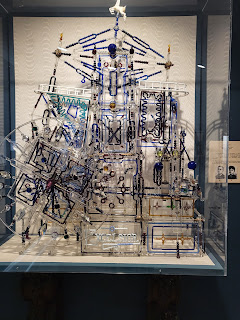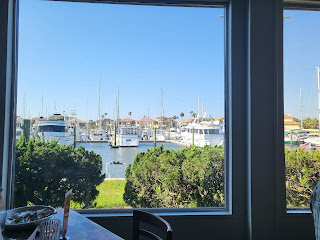Last month I wrote about the St. Augustine, Florida region as an alternative to Disney World where I highlighted destinations that can be particularly enjoyable for families. This month I'm going in a different direction by pointing out places adults are more apt to appreciate.
Remarkable Museums
 |
| The Lightner Museum was once home to the Hotel Alcazar. |
If not for Flagler, the Lightner Museum located at 75 King Street would not exist. The imposing structure was once home to the Hotel Alcazar, which was commissioned by Flagler to appeal to wealthy tourists who traveled south for the winter on his railroad. (Yes, Flagler also owned a railroad, which was completed in 1912 and known as the 8th wonder of the world at the time.) The Hotel Alcazar was designed by New York City architects Carrier and Hastings in the Spanish Renaissance Revival style. The talented architects also designed the New York Public Library and the former Ponce De Leon Hotel, which is located across the street from the Lightner Museum and is now part of Flagler College.
The hotel shuttered its doors in 1932 and was sold later to Chicago Publisher Otto C. Lightner in 1947, who converted it into a place to store his collection of Victorian art. In 1948, Lightner turned the museum over to the city of St. Augustine.
The first floor of the Lightner Museum, known as the Victorian Science and Industry Room, displays rocks, shells and minerals, Native American artifacts, examples of Victorian glassblowing and mechanized musical instruments dating from the 1870s through the 1920s.
 |
| The mechanized musical instrument room displays artifacts dating from the 1870s to the 1920s. |
 |
| The Excelsior dates back to 1850 and was a working glass steam engine. |
The second floor contains cut glass, Victorian art glass and stained-glass work from Louis Comfort Tiffany's studio and others.
 |
| St. Augustine, by Louis Comfort Tiffany. |
The third floor of the Lightner Museum contains sculpture, paintings and furniture.
 |
| "Young Girl Crocheting," 1889, Carrera Marble, signed by Ella Pollock Bidwell. |
 |
| Carved teak with mother-of-pearl inlay from the Arabian Peninsula, ca. 1880. |
 |
| Mahogany, Mother of Pearl, 1920. |
 |
| Visitors of the Lightner Museum dine in what was once a swimming pool at the Hotel Alcazar. |
Another museum worth visiting is the Villa Zorayda Museum, also located on King Street. Built in 1883 by a Boston Hardware Merchant and amateur architect by the name of Franklin Webster Smith, the museum was inspired by Spain's Alhambra. The Villa Zorayda served Smith as a residence for 20 years before the building was leased and transformed into a social club in 1913 by Lebanon immigrant Abraham Mussallems.
 |
| The first room guests see upon arrival. |
 |
| The Harem Room |
 |
| A 1920s roulette wheel reminds visitors that the museum was once a casino. |
.jpg) |
| Photo courtesy of the St. Augustine Lighthouse & Maritime Museum |
The learning experience continues with shipwreck artifacts, WWII-era structures and an exhibit called "At Home with the Harns," which focuses on the life of a lighthouse keeper's family in the 1880s. An interactive exhibit enlightens both adults and children on school activities and games that were popular during the period.
 | ||||||||||||
| View of the Keeper's House from inside the tower (courtesy of the St. Augustine Lighthouse & Maritime Museum). Guests are also invited to stroll the grounds, which feature a butterfly garden, a shipyard play area and nature trails.
The Old Jail If you wish to tour a museum documenting a darker past, there's the Old
Jail Museum located at 167 San Marco Avenue. The jail is tucked into the same area as a few other destinations, like the Ripley's
Believe it or Not Museum and the Oldest
Store Museum, both of which I wrote about last month. The reason I didn't add the old jail to the family activity blog post is because the facts can be very disturbing, but for older children this may not be a problem. A guide dressed like a prisoner tells graphic stories about the inmates and the conditions in which they were held. The jail was in operation from 1891 to 1953 and at least eight prisoners were hanged there. Visitors can view the gallows outside before moving into the structure itself to see the living quarters of approximately 72 prisoners.
The guide relates the story of the huge, sadomasochistic Sheriff Joe Perry who took delight in subjecting the prisoners to the worst conditions possible. What I found particularly interesting was that Perry was the son of a Baptist minister. One would expect the man to have more empathy, but not old Perry. According to our guide, the prisoners were used as free farm laborers during the day and returned to the jail at night where the Florida heat was practically unbearable in such close quarters and where air conditioning was but a dream.
The few female prisoners (about a dozen at any one time) were raped and forced to cook and clean in between. According to records, inmates lasted about two years, before dying from maladies like infection, malnutrition and violence. Today, people share stories of hauntings in the Old Jail, like Sim Jackson, who was hanged in 1908 after murdering his wife with a straight razor. Charlie Powell is also said to roam the grounds. He was thrown in the facility for beheading a man who spread rumors about his wife. Guests who want the opportunity to experience things that go bump in the night can sign up to take a night tour called the Ghosts and Graveyards tour. Day tours are held every 20 minutes from 9:00 a.m. to 4:30 p.m. The Fountain of Youth Archaeological Park The Fountain of Youth Archaeological Park is located at the site of St. Augustine's original settlement. Here guests will receive an education on both the Spanish settlers who arrived in the 1500s and the Native Americans known as the Timucua. Exhibits include a 30-foot-high Discovery Globe illustrating the routes of the explorers who traveled to the New World, along with a Navigators' Planetarium where guests can learn more about the navigational tools used by those early explorers. Also onsite is a reconstructed Timucuan Village and a reconstructed mission called the Mission of Nombre de Dios, now recognized as the first Catholic mission established in the United States and built in 1587 by Franciscan Friars. The Mission was built on the grounds of the Fountain of Youth, discovered through an archeological dig and then recreated on the site where it once stood.
Also located onsite is a blacksmith exhibit, beautiful peacocks that freely roam the grounds and, of course, "The Fountain of Youth." Having worked as a water judge, of course I have to remark upon the water I tasted. It smelled slightly of sulfur and tasted a bit metallic. My husband may have gone back for seconds. We're still waiting for it to work its magic.
Set Sail on a Sunset Cruise Before leaving St. Augustine, we made it a point to set sail on a Sunset Cruise and the photo of the sunset alone was worth it. The 90-minute, adults only cruise aboard the Osprey was a relaxing way to view various landmarks like the Mission Nombre de Dios (the Big Cross), the Bridge of Lions that spans the Intracoastal Waterway, the St. Augustine bayfront and the St. Augustine Lighthouse. Good Eats The Kingfish Grill is located within steps of the Camachee Cove Yacht Harbor and many patrons dine there before taking the sunset cruise. The restaurant offers fresh, delicious food and a beautiful view of the harbor. If you enjoy sushi, this is the place to be. I ordered a spicy tuna roll and it was the best I'd ever had. Accommodations Conveniently located hotels with comfortable accommodations include The Ponce, The Flagler Inn and the Beachers Lodge Oceanfront Suites. The Ponce, located at 111 N. Ponce de Leon Blvd., is a comfortable option, with standard rooms containing two queen-sized beds, an outdoor pool and free internet access.
|






















.jpeg)
.jpg)